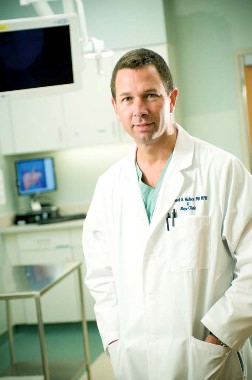User login
Colon cancer, colonoscopy, and intestinal issues
Hereditary syndromes in gastroenterology have emerged from being esoteric to being common issues that all of us must deal with, according to Dr. Sapna Syngal of Dana-Farber/Brigham and Women’s Cancer Center, Boston. Screening, surveillance, and treatment of hereditary cancers are all different, compared with sporadic cancer. For colorectal cancers, an excellent resource is http://www.nccn.org/professionals/physician_gls/pdf/genetics_colon.pdf, and there are recent society summaries (Am. J. Gastroenterol. 2015;110:223-62). These recommend a family history of cancer be recorded for all patients, including type of cancer, age at diagnosis, and relationship to patient. Lynch syndrome testing should now be done on all newly diagnosed colorectal cancers by testing of mismatch repair proteins or microsatellite instability. Genetic testing should be done when these are detected and on all family members of affected individuals. Familial adenomatous polyposis testing, including the APC and MUTYH genes, should be done for individuals with more than 10 cumulative adenomas, or a family history of any familial adenomatous condition. Peutz-Jeghers syndrome should be tested for in individuals with perioral/buccal pigmentation or those with two or more hamartomatous polyps. Juvenile polyposis syndrome should be tested for in individuals with five or more juvenile polyps in the colorectum or any juvenile polyps in other parts of the GI tract. Simple clinical questions can help identify those who should be tested (Am. J. Gastroenterol. 2009;104:1508-18).
Modern evidence has refuted several long-held beliefs about diverticulosis and diverticulitis, said Dr. Neil Stollman of the University of California, San Francisco. Evidence now shows that diverticulosis is not associated with a low-fiber diet and that high-fiber diets are associated with higher rates of diverticular complications, although this may be due to confounding. Nonsteroidal anti-inflammatory drugs are associated with increased risk of diverticular bleeding. The risk of diverticulitis is much lower than previously thought. Prior estimates of 10%-25% have now been revised downward to 1%-4%. Nuts and seeds do not cause acute diverticulitis and do not need to be avoided. Diverticulitis is a spectrum of diseases from asymptomatic to symptomatic uncomplicated diverticular disease (SUDD) to acute diverticulitis. Mesalamine may be effective in SUDD and acute diverticulitis but evidence is mixed. Cyclic rifaximin and probiotics may also be helpful in SUDD. Antibiotics, previously thought to be mandatory in acute diverticulitis, have not been clearly beneficial in large randomized trials. Surgery, which was also previously recommended after a second attack of acute diverticulitis, is now considered optional and should be individualized.
Dr. Douglas K. Rex of Indiana University Health, Indianapolis, reviewed key measures of quality in colonoscopy and how to achieve these, even under difficult circumstances. Key measures include adenoma detection rate, which can be improved through careful attention to good technique (looking behind folds, adequate distention, and washing) and recognition of flat and sessile polyps. New technologies include high definition, special endoscope caps that flatten folds, and new wide-angle colonoscopes. Water immersion and CO2 insufflation have also improved quality through easier insertion and less gas distention and pain after the procedure. For removal of large, lateral spreading polyps, the technique of endoscopic mucosal resection has been highly effective. Use of a “bulking agent” for submucosal injection such as hydroxyethyl starch, injectable contrast agent, underwater endoscopic mucosal resection, and avulsion (with cold or hot forceps) of fibrotic/scarred polyps have all been demonstrated to be effective in expert hands.
Dr. Charlene M. Prather of Saint Louis University summarized the increasing prevalence of constipation and reviewed risk factors (decreased activity, low fiber consumption, and use of multiple constipating medications). Constipation can be divided into three types: normal transit, slow transit, and pelvic floor dysfunction (PFD). Physical exam, particularly a high-quality rectal exam, can be very effective with high negative predictive value for PFD. Treatment includes fiber supplementation (most effective for mild/moderate constipation, less helpful in slow transit or PFD), laxatives (best data are for osmotic laxatives and bisacodyl), and newer agents that stimulate chloride secretion. Testing is appropriate for refractory constipation and includes transit time studies, balloon expulsion, and anorectal manometry.
Dr. Brennan Spiegel of the Cedars-Sinai Center for Outcomes Research and Education, Los Angeles, provided a summary of current national efforts to measure, report, and improve quality in gastroenterology. He highlighted several reports of high variability in quality such as adenoma detection, testing in patients with uncomplicated inflammatory bowel disease, and approaches to diagnosis of irritable bowel syndrome. A general approach to achieving quality was outlined, including: 1. standardization, 2. measurement, 3. reporting, 4. incentivizing (getting paid for performance), and 5. improving. U.S. Medicare oversight groups (PQRS) have chosen four general areas of quality (polyp surveillance, gastroesophageal reflux disease, hepatitis C, and IBD) measures. Gastroenterology societies have provided effective tools to measure and report these, including GIQUIC and the AGA Digestive Health Recognition Program.
Dr. Wallace is professor of medicine and director, digestive diseases research program, Mayo Clinic, Jacksonville, Fla. He has received grants from BSCI and Cosmo and has consulted for Olympus and iLumen. This is a summary provided by the moderator of one of the spring postgraduate course sessions held at DDW 2015.
Hereditary syndromes in gastroenterology have emerged from being esoteric to being common issues that all of us must deal with, according to Dr. Sapna Syngal of Dana-Farber/Brigham and Women’s Cancer Center, Boston. Screening, surveillance, and treatment of hereditary cancers are all different, compared with sporadic cancer. For colorectal cancers, an excellent resource is http://www.nccn.org/professionals/physician_gls/pdf/genetics_colon.pdf, and there are recent society summaries (Am. J. Gastroenterol. 2015;110:223-62). These recommend a family history of cancer be recorded for all patients, including type of cancer, age at diagnosis, and relationship to patient. Lynch syndrome testing should now be done on all newly diagnosed colorectal cancers by testing of mismatch repair proteins or microsatellite instability. Genetic testing should be done when these are detected and on all family members of affected individuals. Familial adenomatous polyposis testing, including the APC and MUTYH genes, should be done for individuals with more than 10 cumulative adenomas, or a family history of any familial adenomatous condition. Peutz-Jeghers syndrome should be tested for in individuals with perioral/buccal pigmentation or those with two or more hamartomatous polyps. Juvenile polyposis syndrome should be tested for in individuals with five or more juvenile polyps in the colorectum or any juvenile polyps in other parts of the GI tract. Simple clinical questions can help identify those who should be tested (Am. J. Gastroenterol. 2009;104:1508-18).
Modern evidence has refuted several long-held beliefs about diverticulosis and diverticulitis, said Dr. Neil Stollman of the University of California, San Francisco. Evidence now shows that diverticulosis is not associated with a low-fiber diet and that high-fiber diets are associated with higher rates of diverticular complications, although this may be due to confounding. Nonsteroidal anti-inflammatory drugs are associated with increased risk of diverticular bleeding. The risk of diverticulitis is much lower than previously thought. Prior estimates of 10%-25% have now been revised downward to 1%-4%. Nuts and seeds do not cause acute diverticulitis and do not need to be avoided. Diverticulitis is a spectrum of diseases from asymptomatic to symptomatic uncomplicated diverticular disease (SUDD) to acute diverticulitis. Mesalamine may be effective in SUDD and acute diverticulitis but evidence is mixed. Cyclic rifaximin and probiotics may also be helpful in SUDD. Antibiotics, previously thought to be mandatory in acute diverticulitis, have not been clearly beneficial in large randomized trials. Surgery, which was also previously recommended after a second attack of acute diverticulitis, is now considered optional and should be individualized.
Dr. Douglas K. Rex of Indiana University Health, Indianapolis, reviewed key measures of quality in colonoscopy and how to achieve these, even under difficult circumstances. Key measures include adenoma detection rate, which can be improved through careful attention to good technique (looking behind folds, adequate distention, and washing) and recognition of flat and sessile polyps. New technologies include high definition, special endoscope caps that flatten folds, and new wide-angle colonoscopes. Water immersion and CO2 insufflation have also improved quality through easier insertion and less gas distention and pain after the procedure. For removal of large, lateral spreading polyps, the technique of endoscopic mucosal resection has been highly effective. Use of a “bulking agent” for submucosal injection such as hydroxyethyl starch, injectable contrast agent, underwater endoscopic mucosal resection, and avulsion (with cold or hot forceps) of fibrotic/scarred polyps have all been demonstrated to be effective in expert hands.
Dr. Charlene M. Prather of Saint Louis University summarized the increasing prevalence of constipation and reviewed risk factors (decreased activity, low fiber consumption, and use of multiple constipating medications). Constipation can be divided into three types: normal transit, slow transit, and pelvic floor dysfunction (PFD). Physical exam, particularly a high-quality rectal exam, can be very effective with high negative predictive value for PFD. Treatment includes fiber supplementation (most effective for mild/moderate constipation, less helpful in slow transit or PFD), laxatives (best data are for osmotic laxatives and bisacodyl), and newer agents that stimulate chloride secretion. Testing is appropriate for refractory constipation and includes transit time studies, balloon expulsion, and anorectal manometry.
Dr. Brennan Spiegel of the Cedars-Sinai Center for Outcomes Research and Education, Los Angeles, provided a summary of current national efforts to measure, report, and improve quality in gastroenterology. He highlighted several reports of high variability in quality such as adenoma detection, testing in patients with uncomplicated inflammatory bowel disease, and approaches to diagnosis of irritable bowel syndrome. A general approach to achieving quality was outlined, including: 1. standardization, 2. measurement, 3. reporting, 4. incentivizing (getting paid for performance), and 5. improving. U.S. Medicare oversight groups (PQRS) have chosen four general areas of quality (polyp surveillance, gastroesophageal reflux disease, hepatitis C, and IBD) measures. Gastroenterology societies have provided effective tools to measure and report these, including GIQUIC and the AGA Digestive Health Recognition Program.
Dr. Wallace is professor of medicine and director, digestive diseases research program, Mayo Clinic, Jacksonville, Fla. He has received grants from BSCI and Cosmo and has consulted for Olympus and iLumen. This is a summary provided by the moderator of one of the spring postgraduate course sessions held at DDW 2015.
Hereditary syndromes in gastroenterology have emerged from being esoteric to being common issues that all of us must deal with, according to Dr. Sapna Syngal of Dana-Farber/Brigham and Women’s Cancer Center, Boston. Screening, surveillance, and treatment of hereditary cancers are all different, compared with sporadic cancer. For colorectal cancers, an excellent resource is http://www.nccn.org/professionals/physician_gls/pdf/genetics_colon.pdf, and there are recent society summaries (Am. J. Gastroenterol. 2015;110:223-62). These recommend a family history of cancer be recorded for all patients, including type of cancer, age at diagnosis, and relationship to patient. Lynch syndrome testing should now be done on all newly diagnosed colorectal cancers by testing of mismatch repair proteins or microsatellite instability. Genetic testing should be done when these are detected and on all family members of affected individuals. Familial adenomatous polyposis testing, including the APC and MUTYH genes, should be done for individuals with more than 10 cumulative adenomas, or a family history of any familial adenomatous condition. Peutz-Jeghers syndrome should be tested for in individuals with perioral/buccal pigmentation or those with two or more hamartomatous polyps. Juvenile polyposis syndrome should be tested for in individuals with five or more juvenile polyps in the colorectum or any juvenile polyps in other parts of the GI tract. Simple clinical questions can help identify those who should be tested (Am. J. Gastroenterol. 2009;104:1508-18).
Modern evidence has refuted several long-held beliefs about diverticulosis and diverticulitis, said Dr. Neil Stollman of the University of California, San Francisco. Evidence now shows that diverticulosis is not associated with a low-fiber diet and that high-fiber diets are associated with higher rates of diverticular complications, although this may be due to confounding. Nonsteroidal anti-inflammatory drugs are associated with increased risk of diverticular bleeding. The risk of diverticulitis is much lower than previously thought. Prior estimates of 10%-25% have now been revised downward to 1%-4%. Nuts and seeds do not cause acute diverticulitis and do not need to be avoided. Diverticulitis is a spectrum of diseases from asymptomatic to symptomatic uncomplicated diverticular disease (SUDD) to acute diverticulitis. Mesalamine may be effective in SUDD and acute diverticulitis but evidence is mixed. Cyclic rifaximin and probiotics may also be helpful in SUDD. Antibiotics, previously thought to be mandatory in acute diverticulitis, have not been clearly beneficial in large randomized trials. Surgery, which was also previously recommended after a second attack of acute diverticulitis, is now considered optional and should be individualized.
Dr. Douglas K. Rex of Indiana University Health, Indianapolis, reviewed key measures of quality in colonoscopy and how to achieve these, even under difficult circumstances. Key measures include adenoma detection rate, which can be improved through careful attention to good technique (looking behind folds, adequate distention, and washing) and recognition of flat and sessile polyps. New technologies include high definition, special endoscope caps that flatten folds, and new wide-angle colonoscopes. Water immersion and CO2 insufflation have also improved quality through easier insertion and less gas distention and pain after the procedure. For removal of large, lateral spreading polyps, the technique of endoscopic mucosal resection has been highly effective. Use of a “bulking agent” for submucosal injection such as hydroxyethyl starch, injectable contrast agent, underwater endoscopic mucosal resection, and avulsion (with cold or hot forceps) of fibrotic/scarred polyps have all been demonstrated to be effective in expert hands.
Dr. Charlene M. Prather of Saint Louis University summarized the increasing prevalence of constipation and reviewed risk factors (decreased activity, low fiber consumption, and use of multiple constipating medications). Constipation can be divided into three types: normal transit, slow transit, and pelvic floor dysfunction (PFD). Physical exam, particularly a high-quality rectal exam, can be very effective with high negative predictive value for PFD. Treatment includes fiber supplementation (most effective for mild/moderate constipation, less helpful in slow transit or PFD), laxatives (best data are for osmotic laxatives and bisacodyl), and newer agents that stimulate chloride secretion. Testing is appropriate for refractory constipation and includes transit time studies, balloon expulsion, and anorectal manometry.
Dr. Brennan Spiegel of the Cedars-Sinai Center for Outcomes Research and Education, Los Angeles, provided a summary of current national efforts to measure, report, and improve quality in gastroenterology. He highlighted several reports of high variability in quality such as adenoma detection, testing in patients with uncomplicated inflammatory bowel disease, and approaches to diagnosis of irritable bowel syndrome. A general approach to achieving quality was outlined, including: 1. standardization, 2. measurement, 3. reporting, 4. incentivizing (getting paid for performance), and 5. improving. U.S. Medicare oversight groups (PQRS) have chosen four general areas of quality (polyp surveillance, gastroesophageal reflux disease, hepatitis C, and IBD) measures. Gastroenterology societies have provided effective tools to measure and report these, including GIQUIC and the AGA Digestive Health Recognition Program.
Dr. Wallace is professor of medicine and director, digestive diseases research program, Mayo Clinic, Jacksonville, Fla. He has received grants from BSCI and Cosmo and has consulted for Olympus and iLumen. This is a summary provided by the moderator of one of the spring postgraduate course sessions held at DDW 2015.
Jack Vennes M.D. and Stephen E. Silvis M.D. Endowed Lecture: Optical biopsy
Recent advances in endoscopic imaging technology increasingly have allowed highly accurate in vivo assessment of tissue, including specific pathologic diagnoses of inflammation and neoplasia. As endoscopic imaging technology advances, we are increasingly asked whether tissue biopsy of suspicious lesions is critical or can be replaced with "optical" biopsy.
Histology will remain a key component of gastrointestinal diagnoses, but there will be important changes in how we can integrate with pathology services. These will include reduction in the number of low-yield biopsies such as random biopsies in Barrett’s esophagus, inflammatory bowel disease, and small distal non-neoplastic colorectal polyps and increasing targeting of biopsy using advanced imaging. Lastly, health care reform will increasingly drive us to reform our practices towards lower-cost, higher-value services, which include reductions in the histological evaluation of low-risk tissues. The main value of histologic analysis is the very high level of magnification, resolution, and contrast provided by standard light microscopy. Increasingly, endoscopes are capable of achieving similar levels of magnification, resolution, and contrast.
As the number of endoscopies has increased over the last few decades – over 20 million procedures are now performed annually – the cost associated with these has increased substantially. Although the cost of the endoscopy itself is an important component, the cost of ancillary services, including histology as well as anesthesia, is becoming increasingly important. This is particularly true in screening and surveillance colonoscopies, where now more than 50% of all procedures generate a histologic sample.
Advances in endoscopic optics have achieved remarkable levels of resolution and magnification over the last several decades. Important advances include the development of high-definition optical enhanced imaging and, more recently, confocal endomicroscopy. Also, inexpensive technologies such as chromoendoscopy have dramatically increased the yield of neoplasia in inflammatory bowel disease, compared with random biopsies alone. In Barrett’s esophagus, use of high-definition optical enhanced endoscopes has been shown to increase the yield of dysplasia with fewer biopsies. Confocal endomicroscopy also has been shown to be highly accurate for detection of neoplasia in Barrett’s esophagus, with overall accuracy of use exceeding 95%. A limitation of highly focused imaging technology is the small field of view that is imaged. A recent major advance is volumetric laser endomicroscopy, which provides high-resolution, high magnification imaging of large surface areas, including the entire esophagus.
Apart from advances in technology, a major impetus for adoption of optical biopsy technique will be payment reform such as bundled payments which provide payments for the endoscopy and all ancillary services such as pathology. In summary, optical biopsy with advanced endoscopic instruments now rivals the accuracy and resolution of ex vivo microscopy. The increasing cost of health care will drive reform with pressure to reduce the utilization and cost of low-value histology services. Lastly, the community of endoscopists must increasingly learn the skills to make highly accurate endomicroscopic diagnoses.
Dr. Michael B. Wallace, MPH, Professor of Medicine, Mayo Clinic, Jacksonville, Fla.
Recent advances in endoscopic imaging technology increasingly have allowed highly accurate in vivo assessment of tissue, including specific pathologic diagnoses of inflammation and neoplasia. As endoscopic imaging technology advances, we are increasingly asked whether tissue biopsy of suspicious lesions is critical or can be replaced with "optical" biopsy.
Histology will remain a key component of gastrointestinal diagnoses, but there will be important changes in how we can integrate with pathology services. These will include reduction in the number of low-yield biopsies such as random biopsies in Barrett’s esophagus, inflammatory bowel disease, and small distal non-neoplastic colorectal polyps and increasing targeting of biopsy using advanced imaging. Lastly, health care reform will increasingly drive us to reform our practices towards lower-cost, higher-value services, which include reductions in the histological evaluation of low-risk tissues. The main value of histologic analysis is the very high level of magnification, resolution, and contrast provided by standard light microscopy. Increasingly, endoscopes are capable of achieving similar levels of magnification, resolution, and contrast.
As the number of endoscopies has increased over the last few decades – over 20 million procedures are now performed annually – the cost associated with these has increased substantially. Although the cost of the endoscopy itself is an important component, the cost of ancillary services, including histology as well as anesthesia, is becoming increasingly important. This is particularly true in screening and surveillance colonoscopies, where now more than 50% of all procedures generate a histologic sample.
Advances in endoscopic optics have achieved remarkable levels of resolution and magnification over the last several decades. Important advances include the development of high-definition optical enhanced imaging and, more recently, confocal endomicroscopy. Also, inexpensive technologies such as chromoendoscopy have dramatically increased the yield of neoplasia in inflammatory bowel disease, compared with random biopsies alone. In Barrett’s esophagus, use of high-definition optical enhanced endoscopes has been shown to increase the yield of dysplasia with fewer biopsies. Confocal endomicroscopy also has been shown to be highly accurate for detection of neoplasia in Barrett’s esophagus, with overall accuracy of use exceeding 95%. A limitation of highly focused imaging technology is the small field of view that is imaged. A recent major advance is volumetric laser endomicroscopy, which provides high-resolution, high magnification imaging of large surface areas, including the entire esophagus.
Apart from advances in technology, a major impetus for adoption of optical biopsy technique will be payment reform such as bundled payments which provide payments for the endoscopy and all ancillary services such as pathology. In summary, optical biopsy with advanced endoscopic instruments now rivals the accuracy and resolution of ex vivo microscopy. The increasing cost of health care will drive reform with pressure to reduce the utilization and cost of low-value histology services. Lastly, the community of endoscopists must increasingly learn the skills to make highly accurate endomicroscopic diagnoses.
Dr. Michael B. Wallace, MPH, Professor of Medicine, Mayo Clinic, Jacksonville, Fla.
Recent advances in endoscopic imaging technology increasingly have allowed highly accurate in vivo assessment of tissue, including specific pathologic diagnoses of inflammation and neoplasia. As endoscopic imaging technology advances, we are increasingly asked whether tissue biopsy of suspicious lesions is critical or can be replaced with "optical" biopsy.
Histology will remain a key component of gastrointestinal diagnoses, but there will be important changes in how we can integrate with pathology services. These will include reduction in the number of low-yield biopsies such as random biopsies in Barrett’s esophagus, inflammatory bowel disease, and small distal non-neoplastic colorectal polyps and increasing targeting of biopsy using advanced imaging. Lastly, health care reform will increasingly drive us to reform our practices towards lower-cost, higher-value services, which include reductions in the histological evaluation of low-risk tissues. The main value of histologic analysis is the very high level of magnification, resolution, and contrast provided by standard light microscopy. Increasingly, endoscopes are capable of achieving similar levels of magnification, resolution, and contrast.
As the number of endoscopies has increased over the last few decades – over 20 million procedures are now performed annually – the cost associated with these has increased substantially. Although the cost of the endoscopy itself is an important component, the cost of ancillary services, including histology as well as anesthesia, is becoming increasingly important. This is particularly true in screening and surveillance colonoscopies, where now more than 50% of all procedures generate a histologic sample.
Advances in endoscopic optics have achieved remarkable levels of resolution and magnification over the last several decades. Important advances include the development of high-definition optical enhanced imaging and, more recently, confocal endomicroscopy. Also, inexpensive technologies such as chromoendoscopy have dramatically increased the yield of neoplasia in inflammatory bowel disease, compared with random biopsies alone. In Barrett’s esophagus, use of high-definition optical enhanced endoscopes has been shown to increase the yield of dysplasia with fewer biopsies. Confocal endomicroscopy also has been shown to be highly accurate for detection of neoplasia in Barrett’s esophagus, with overall accuracy of use exceeding 95%. A limitation of highly focused imaging technology is the small field of view that is imaged. A recent major advance is volumetric laser endomicroscopy, which provides high-resolution, high magnification imaging of large surface areas, including the entire esophagus.
Apart from advances in technology, a major impetus for adoption of optical biopsy technique will be payment reform such as bundled payments which provide payments for the endoscopy and all ancillary services such as pathology. In summary, optical biopsy with advanced endoscopic instruments now rivals the accuracy and resolution of ex vivo microscopy. The increasing cost of health care will drive reform with pressure to reduce the utilization and cost of low-value histology services. Lastly, the community of endoscopists must increasingly learn the skills to make highly accurate endomicroscopic diagnoses.
Dr. Michael B. Wallace, MPH, Professor of Medicine, Mayo Clinic, Jacksonville, Fla.



